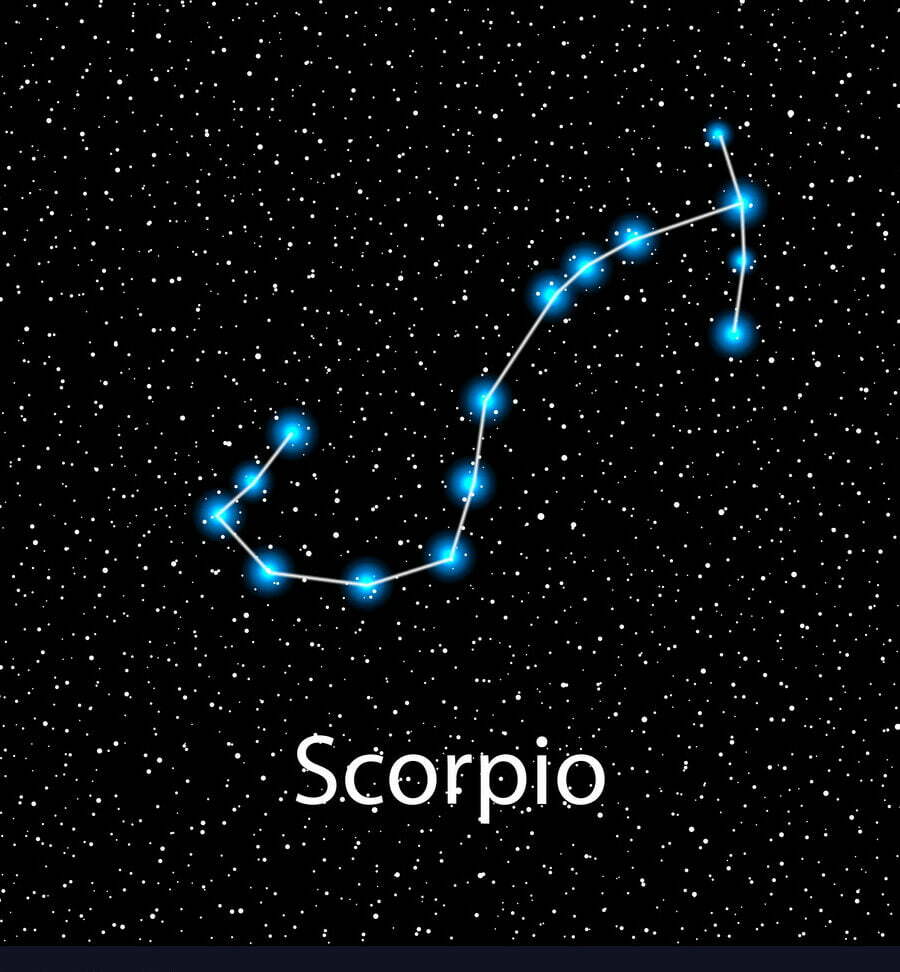The zodiac sign Scorpio dominates from October 23 to November 22. It is associated with the Scorpio constellation.
Represented by a poisonous arthropod, the symbolic image of Scorpio highlights the responsibility of individuals born under this sign towards themselves and others. It also emphasizes the importance of continuous transformation. In fact, envisioning a Scorpio stagnant in personal growth is extremely challenging, as these individuals are perpetually working on themselves.
The well-known depiction of Scorpio as the Latin letter “m” with a stinging tail is shrouded in mystery. While some link it to a medieval alchemical symbol representing filtration, it is evident that the Scorpio symbol predates that era.

The sting of the Scorpion is depicted as an upward pointing arrow that extends to the lower right end of the letter. Individuals born under the Scorpio zodiac sign are known for their vindictive nature. Additionally, this symbol represents the idea of upward movement, striving for goals, and taking active steps towards achieving them.
What is the difference between the sign of Scorpio and the constellation of Scorpio?
The constellation of Scorpio is where the Sun passes through from November 23 to 29. It’s interesting to note that this real astronomical event does not align with the astrological calendar, and the duration of the passage is relatively short compared to the time that the sign of Scorpio reigns in the zodiac.
The reason for the discrepancy between the passage of the Sun through the constellation of Scorpio and the astrological data is due to the phenomenon of precession. The Earth’s rotation around its axis is not perfectly smooth, and over millennia, it deviates and makes a revolution around its own poles. As a result, the stars above us shift, causing inconsistencies with the readings of the zodiacal circle.
Nevertheless, after a complete rotation of the Earth around the pole, the position of the stars will once again align with the Zodiacal data, which is estimated to occur in 23,000 years.
Famous individuals born under the Scorpio zodiac sign
How can you locate the Scorpio constellation?
Scorpio is regarded as one of the most enigmatic signs in astrology. In the field of astronomy, the Scorpio constellation is an intriguing combination of celestial objects, encompassing not only stars of varying magnitudes, but also multiple star clusters and nebulae.
The brightest star within the constellation, known as its alpha star, is the red supergiant Antares. It is ranked as the 16th brightest star in the known universe.
The constellation’s second brightest star is known as Shaula, which gets its name from the Arabic word for “raised.” This refers to its position at the tail end of the constellation, resembling a raised tail or sting. Shaula is made up of three sources of light and ranks as the twenty-fifth brightest star. It is located approximately seven hundred light-years away from our solar system and has an age of over ten million years.

Beta Scorpio, also known as Aqrab in Arabic, is the sixth brightest star in the Scorpius constellation. It is also referred to as Graffias, which means “claws” in Arabic, and Raffias, which means “crab” in Greek.
Dshubba, also known as Delta Scorpio, is located 490 light-years away from Earth. It is not just one star, but a complex of several luminaries. Dshubba gets its name from the Arabic word for “forehead”.
An intriguing celestial object is Theta Scorpio, known as Sargas. This designation originates from the ancient Sumerian language, although its exact meaning remains a mystery. Sargas stands out as a luminous yellow giant, boasting a mass approximately three and a half times that of our Sun. Eventually, as the star depletes its helium reserves, it will undergo a transformation into a white dwarf.
Scorpius belongs to the group of constellations visible in the Southern Hemisphere. Consequently, when observing from the territory of Russia, it traverses the southern portion of the sky, situated relatively low above the horizon. The optimal months for observing this constellation are May and June.
Within the middle latitudes, the most prominent star in Scorpius is Antares, which can be regarded as the metaphorical head of the celestial scorpion. To locate it, direct your gaze towards the south.
As you embark on your search for Scorpius, notable guideposts include the constellation Virgo, which can act as a mental starting point for tracing a route towards the southeast through the constellation Libra.
Scorpio Constellation: Debunking the Myth
According to an ancient Greek myth, the Earth goddess Gaia grew furious with the renowned hunter Orion, who boasted about his ability to eradicate all creatures on Earth. To teach him a lesson, Gaia dispatched a venomous scorpion to confront Orion.
Using its deadly venom, the scorpion managed to poison Orion, leading to his demise. As a token of appreciation for its services, the gods immortalized the scorpion in the night sky by transforming it into a constellation. Orion, too, was transformed into a constellation as a reminder that arrogance and hubris are met with punishment. Furthermore, this celestial arrangement serves as a symbol of the futility of trying to exterminate all life, as nature always finds a way to replenish and rejuvenate itself, just as winter gives way to spring.
In the 2nd century, the renowned Greek geographer and mathematician Ptolemy incorporated it into his celestial atlas “Almagest”. Scorpio hosts the Sun for merely six days in November, specifically from the 24th to the 29th, while it corresponds to the zodiac sign with the same name from October 24th to November 22nd.
What exactly is the zodiac?
As the Sun completes its annual journey across the sky, it traces out a circular path known as the ecliptic. This line serves as a reference point for astronomers, who have identified a narrow strip surrounding it where the Moon and the planets of our solar system appear to move.
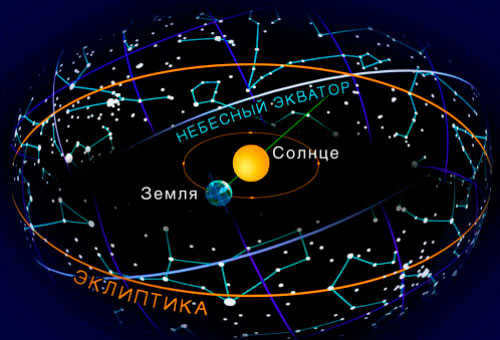
The 12 zodiacal constellations are traversed by the ecliptic.
The ancient Babylonians were the first to discover the belt encircling the ecliptic, which they subsequently divided into 12 equal sections. These divisions were later referred to as the zodiac by the ancient Greeks. The name zodiac is derived from the same root as the word “zoo,” as people associated the constellations in this belt with animals.
Scorpius: a brief historical overview
Scorpius, one of the twelve constellations in the zodiac, is located between Libra to the west and Sagittarius to the east. It also shares borders with the non-zodiacal constellations of Serpent and Sacristan.
The arrangement of stars in Scorpius does indeed resemble a scorpion, as observed by ancient Greek astronomers who identified its body, tail, and claws.
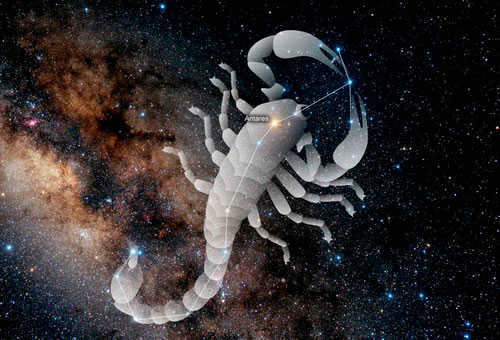
The constellation was named around 2,000 years ago and, like many other celestial objects, it was named after an ancient Greek myth. Artemis, the goddess of fertility, was furious with the hunter Orion, who boasted about killing all the animals on Earth, so she sent a scorpion to silence him.
A battle ensued, in which the venomous sting of the scorpion cost the young man his life. Zeus then transformed both Orion and the scorpion into constellations in the sky. Interestingly, their mythological story is “reflected” in the celestial geography: when Scorpio rises, Orion disappears below the horizon, as if fleeing from the scorpion.
Characterization. The primary celestial bodies
This group of stars consists of 162 stars that can be seen with the naked eye, out of which 7 are useful for navigation purposes (meaning they can be used for navigation on land and at sea). It also contains numerous nebulae, scattered clusters, newly formed stars, and several supergiants.
One distinctive characteristic of Scorpius is its luminosity – its tail is immersed in the brightest region of the Milky Way. The celestial objects found in that area emit light thousands of times brighter than the Sun.
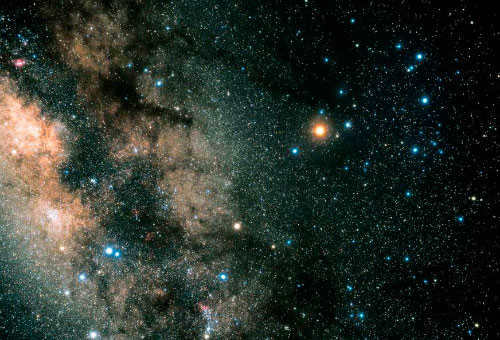
A celestial crustacean is observing us.
The primary stars of Scorpio (arranged in descending order of brightness):
- Antares is a vibrant orange, ranking as the 15th brightest star in the entire sky. Due to its reddish tint, it is also known as the rival of Mars.
- Aqrab is a binary system, appearing blue-white. Interestingly, it is featured on the flag of Brazil, where it symbolizes one of the states according to a long-standing legend.
- Dshubba is blue-white and displays variable luminosity. Its name translates from Arabic as “forehead”.
- Shaula is bluish and consists of three components. The Arabic translation of its name is “sting”.
- Sargas is a stable giant double star with a yellow hue.
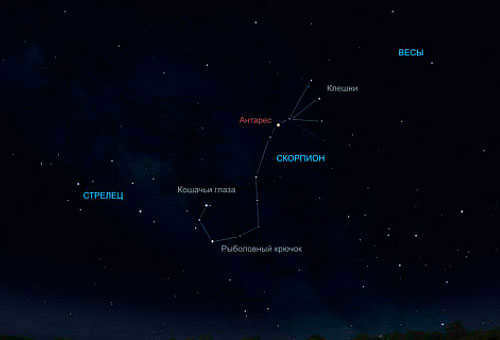
Antares, the brightest star in the constellation Scorpius, is also one of the brightest stars in the entire sky.
What Makes Scorpius Interesting
Scorpius is a constellation that has attracted significant attention from scientists due to its unique features. It contains numerous star clusters that are of great interest to the scientific community.
One intriguing aspect of Scorpius is the occurrence of new stars, specifically flares that suddenly increase in luminosity. These flares have even deceived ancient astronomers, leading them to revise their celestial catalogs.
One of the most fascinating objects within Scorpius is the neutron star X-1, which emits the most powerful X-ray radiation ever observed in space.
Where to find Scorpius
Due to its position low above the horizon, it can be challenging to observe Scorpius in the sky, particularly in the middle latitudes. Some regions in Russia, like Moscow, may not have the opportunity to see it. To catch a glimpse of Scorpius, one needs to be located at least at the latitude of Rostov-on-Don or further south.
On a cloudless night, if one looks towards the southeastern side of the sky from the ground, the constellation will be visible, aligned with the Milky Way. Its distinctive shape, resembling a clear letter J, makes it easy to recognize.
Scorpio – The Mystical Zodiac Sign
Astrology also employs celestial charts to create horoscopes for the various “personalities” within the annual zodiac cycle. Additionally, it provides a comprehensive portrayal of individuals born under the Scorpio sign.
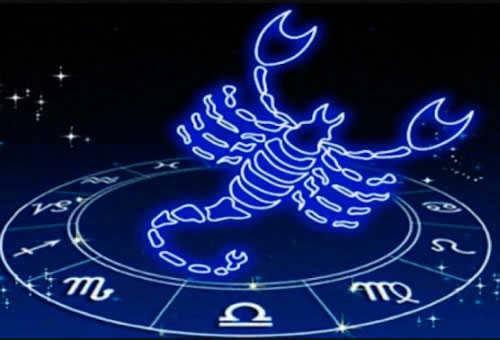
Scorpio is the eighth astrological sign in the Zodiac.
Astrologers characterize Scorpios as individuals with fearlessness, directness, and strong determination. Moreover, they possess exceptional intuition and often exhibit true wisdom. These individuals are highly talented and alluring, consistently displaying leadership traits. However, it is impossible to impose one’s will on a Scorpio or restrict their freedom.
- Scorpio (Latin: Scorpius) is a constellation in the southern part of the sky, positioned between Sagittarius to the east and Libra to the west. It is fully within the Milky Way and is bordered by the Serpentor constellation to the north and the Sacrifice constellation to the south.
Related ideas
Cassiopeia (Latin: Cassiopeia) is a constellation located in the Northern Hemisphere of the sky. The brightest stars in Cassiopeia form a shape that resembles the letters “M” or “W”. This constellation covers an area of 598.4 square degrees in the sky and contains approximately 90 stars that are brighter than 6m (visible to the naked eye). Most of Cassiopeia lies within the Milky Way and is home to numerous scattered star clusters.
The constellation Aquila, also known as Eagle in Latin, is located along the equator. It is situated in the eastern branch of the Milky Way, to the south of the constellation Arrow. Aquila covers an area of 652.5 square degrees and contains a total of 70 stars with a brightness greater than 6m.
Cepheus, or Cepheus in Latin, is a constellation in the Northern Hemisphere. It has an irregular pentagon shape and the southern part of the constellation lies within the Milky Way. Cepheus covers an area of 587.8 square degrees in the sky and is home to 148 stars that can be seen without the aid of a telescope.
Ara is a constellation located in the southern part of the sky. It covers an area of 237.0 square degrees and contains around 60 stars that can be seen without the aid of a telescope. In the southern regions of Russia, specifically south of latitude 44° 30′, a small section of the constellation can be observed just above the horizon during the months of May and June. However, this particular area does not have any prominent bright stars. One notable star, α Sacristan, which has a magnitude of 2.95, cannot be seen in Russia. Nevertheless, in certain favorable conditions, it is possible to catch a glimpse of this star near the horizon line in southern cities within the post-Soviet space that are situated south of latitude 40° 08′ (such as Bukhara, Samarkand, and Nakhichevan).
References in literary works
The French government is currently in possession of the oldest known example of the circular zodiac, which was discovered in Tentir, Egypt. This fascinating zodiac, described by Mr. John Cole, consists of a medallion with engraved constellations measuring 1½ feet in diameter. The medallion is surrounded by a larger circle adorned with hieroglyphic images, which is then enclosed within a square measuring 2 meters 40 centimeters on each side. The zodiacal constellations, along with other stars, are depicted on a spiral. The spiral begins with Leo, depicted as the head of the procession, trampling a serpent while a woman holds onto his tail. Following Leo, we see the Virgin with ears of grain, two bowls on scales with Harpocrates above them, Scorpio, Sagittarius with wings and two faces, Capricorn, Aquarius, Pisces, Aries, Taurus, and Gemini. Finally, this zodiacal procession culminates with Cancer, also known as the Crab.
2. Right above you, there is a stretched-out triangle formed by extremely bright and noticeable stars, known as the Summer Triangle (Fig. 7). One of the stars at the corner of the triangle is named Deneb, and it happens to be the most luminous star in the Swan constellation. The Swan gracefully glides along the Milky Way, which can only be witnessed on exceptionally clear nights away from the glow of urban cities. Another star within the Triangle is Vega, belonging to the Lyra constellation. Additionally, Altair, positioned at the heart of the Milky Way, completes the trio. In the southern sky, a red-hued star called Antares, found in the Scorpius constellation, flickers brightly.
The ancient civilizations of the Middle East, such as the Sumerians, Greeks, and Phoenicians, were fascinated by the movements of the Sun, Moon, and stars. They observed that the Sun’s path varied depending on the season, with its rise and fall shifting from north to south. The Moon and the planets, which the Greeks referred to as “mobile” stars, followed a similar trajectory among the other stars. This celestial dance served as a useful tool for shepherds and farmers to predict the seasons. They took note of specific stars that rose before dawn or set after sunset during different times of the year. To preserve this knowledge, they assigned names to these important stars. Over time, these stars became associated with deities in their respective cultures. The ancient Sumerians, for example, named constellations in the Zodiac, a region of the sky traversed by the Sun, Moon, and planets. The Zodiac derives its name from the Greek words “zōdiacos cyclos,” meaning “animal circle,” as many constellations in this area have names that refer to animals, such as Leo, Taurus, Scorpio, Pisces, and Cancer.
The zodiac is a group of 12 constellations that can be seen along the annual path of the Sun among the stars. These constellations include Aries, Taurus, Gemini, Cancer, Leo, Virgo, Libra, Scorpio, Sagittarius, Capricorn, Aquarius, and Pisces. Interestingly, there is one additional constellation called Serpentine that the Sun passes through from November 30 to December 18, but it is not considered part of the zodiac. This may be because the number 12 aligns better with the number of months in a year. The region where the zodiacal constellations are located is known as the zodiacal circle or simply the zodiac. The name “zodiac” comes from the Greek word “zōidiakós,” which means “animal,” likely because many of the constellations in the zodiac are named after animals. It’s worth noting that the visible paths of the Moon, planets, and most asteroids also traverse the zodiacal constellations.
Constellations are the name given to the star systems that make up the Galaxy. These constellations are the largest ones and have been known since ancient times. The sky filled with stars that can be observed from Earth is divided into 88 constellations, with 12 of them forming the zodiacal circle. The zodiacal circle, also known as the zodiac, comes from the Greek words “Zoon” meaning “animal” and “diakos” meaning “wheel”, which translates to “animal circle”. The 12 constellations that form the zodiac are Aries, Taurus, Gemini, Cancer, Leo, Virgo, Libra, Scorpio, Sagittarius, Capricorn, Aquarius, and Pisces.
Continuation of Related Concepts
Constellations are divisions of the celestial sphere used in modern astronomy to facilitate navigation through the starry sky. In ancient times, constellations were referred to as distinctive shapes formed by bright stars.
Orion (Greek: Ὠρίων) is a constellation located near the celestial equator. It is named after the hunter Orion from Greek mythology.
The Swan is a constellation found in the northern hemisphere of the sky. Its bright stars create a unique cross-shaped pattern known as the Northern Cross, which stretches along the Milky Way. In ancient times, people associated this constellation with birds in flight. The Babylonians referred to it as the “forest bird,” while the Arabs called it the “chicken.”
Taurus is a constellation of the zodiac that is situated between Gemini and Aries. It can be found northwest of Orion. The most prominent stars in Taurus include Aldebaran (with an apparent sidereal magnitude of 0.87), Nat (1.65), Alcyone (2.85), and ζ Taurus (2.97). Within the Taurus constellation, there are several dispersed star clusters, namely the Hyades and the Pleiades. Additionally, the constellation is home to the Crab Nebula which contains the pulsar PSR B0531+21.
On the other hand, the constellation Ascendant (known as Auriga in Latin) is located in the northern hemisphere of the sky. Its brightest star is Capella, which has a visual magnitude of 0.1. The best time to observe this constellation is during the months of December and January. It is visible throughout Russia.
Capricornus, also known as Capricorn, is a constellation in the southern hemisphere of the sky. It is situated between Aquarius and Sagittarius. The best time for observing this constellation is during the months of July and August. Capricornus can be seen in the southern and central regions of Russia.
Cancer, on the other hand, is a rather inconspicuous constellation that can only be observed on a clear night. It is located between the constellations of Leo and Gemini. The brightest star in Cancer, which is called β Cancer, has an apparent magnitude of 3.53m.
Perseus is a constellation located in the northern part of the celestial sphere. It was named after the legendary Greek hero who defeated the Gorgon Medusa. This constellation is part of the 48 constellations listed by Ptolemy and has been officially recognized as one of the 88 modern constellations by the International Astronomical Union. One of its notable features is the variable star Algol, also known as β Persei. Perseus is also associated with the annual Perseid meteor shower, which has its radiant point within this constellation.
Lyra, also known as Lyr or લેયરા in Gujarati, is a small constellation located in the northern hemisphere. It lies between the constellations Hercules and Cygnus, forming a triangular shape.
Sails, also known as Vela, is a constellation located in the southern hemisphere of the celestial sphere. Its southern border aligns with the richest parts of the Milky Way. Covering an area of 499.6 square degrees in the sky, it contains 195 stars that are visible to the naked eye.
Naugol (also known as Norma in Latin) is a constellation located in the southern hemisphere of the sky. It is situated southwest of Scorpius and north of the Southern Triangle, with some parts of it contacting the Circulus. Despite being crossed by both branches of the Milky Way, this region of the sky is not abundant in bright stars. In fact, there are no stars in the constellation that have a visual sidereal magnitude brighter than 4.0. However, it is still possible to observe 42 stars with the naked eye in this area, which spans a sky area of 165.3 square degrees. The best time for observations of Naugol is during the months of May and June. It is partially visible in southern Russia, specifically south of 48 N.
The constellation known as Monoceros, which is the Latin name for Unicorn, is located in the equatorial region of the sky. It covers a total area of 481.6 square degrees and consists of 146 stars that can be seen without the aid of a telescope. Despite being situated in the Milky Way, Monoceros does not contain any particularly bright stars. However, its position within the winter triangle, which is formed by the prominent stars Sirius, Procyon, and Betelgeuse, makes it relatively easy to locate. Monoceros is one of the 15 constellations that the celestial equator passes through, and it is visible in both the central and southern regions of the sky.
The constellation Phoenix, also known by its Latin name Phoenix or Phe, can be found in the southern hemisphere of the sky. It covers an area of 469.3 square degrees and contains a total of 68 stars that are visible to the naked eye.
Zajac (Latin: Lepus) is a constellation located in the southern hemisphere of the night sky. It covers an area of 290.3 square degrees and contains a total of 72 stars that can be seen with the naked eye. This constellation is observed in various regions of Russia, mainly in the central and southern parts. The optimal time to observe Zajac is during the month of December.
Korma (Latin: Puppis, Pup) is another constellation found in the southern hemisphere of the celestial sphere. It is situated within the Milky Way and covers an area of 673.4 square degrees. There are a total of 241 stars within this constellation that are visible to the naked eye. Korma can be partially seen across Russia, with the southern regions offering the best visibility. The brightest star in this constellation, ζ Korma, becomes visible at a latitude of 50°. In Adler, this star rises at approximately 6°30', while in the southernmost towns of Dagestan it rises at around 8°30'.
Kiel, also known as Carina or Car, is a constellation located in the southern hemisphere of the night sky. It covers an area of 494.2 square degrees and contains 206 stars that can be seen without the aid of a telescope. Unfortunately, this constellation cannot be observed in Russia. In the former USSR, only a small portion of Kiel, which includes the star Canopus, is visible in the southernmost regions. In Kushka, Canopus rises just 2 degrees above the horizon, in Termez it is barely visible at 0°04’49”, and in Ashgabat it is completely invisible. Nevertheless, Kiel still boasts other prominent stars.
Aries is a well-known constellation in the zodiac, despite lacking any stars that are brighter than the second magnitude. The three primary stars, Hamal (referred to as the “head of the ram”), Sheratan (which means “mark” or “sign”), and Mezartim (designated as α, β, and γ of Aries, respectively) can be easily located as they are positioned to the south of the Triangle. Interestingly, Mesartim, a star of fourth magnitude, was among the earliest double stars to be observed using a telescope, with its discovery credited to Robert Hooke in 1664.
Serpens is a constellation located on the celestial equator. It covers an expansive area of 636.9 square degrees in the night sky and boasts a total of 106 stars that can be seen without the aid of a telescope. The optimal time for observing this constellation is during the month of June. It is visible from all regions within the vast territory of Russia. What sets Serpens apart from other constellations is its unique composition, as it is the sole constellation comprised of two separate and unrelated parts. These parts are divided by the constellation Serpentes, with the “Snake’s Head” positioned to the northwest and the “Snake’s Tail” situated towards the east.
The Crane constellation (Latin: Grus) can be observed in the southern hemisphere of the sky. In Russia, it is visible partially in the southern regions, specifically those south of 53°N. One of the notable stars in Crane is Alnair, which has a sidereal magnitude of 1.7 and is located 100 light-years away. This star is used in astronavigation. Crane is situated between South Fish in the north and Tucana in the south. It covers an area of 365.5 square degrees in the sky and contains 53 stars that can be seen with the naked eye.
The Fox constellation (Latin: Vulpecula, Vul) is a relatively faint constellation found in the northern hemisphere. It lies within the Summer Triangle.
Pisces is a large zodiacal constellation that lies between Aquarius and Aries. It is commonly divided into two sections: “northern Pisces” located beneath Andromeda, and “western Pisces” situated between Pegasus and Aquarius.
Hercules (Latin: Hercules) is a group of stars forming a constellation located in the northern hemisphere of the sky. With an area spanning 1225.1 square degrees, it consists of 235 stars that can be seen with the naked eye. This constellation is visible throughout Russia and reaches its highest point in the zenith region in the southern part of the country and the former USSR. The most optimal conditions for observing Hercules occur in June.
Hydra (Greek ύδρα, Latin Hydra, named after a creature from Greek mythology) is another constellation located in the southern hemisphere of the sky. The brightest star in Hydra, known as Alfard, has a visual magnitude of 2.0. The best time to see this constellation is from February to March. While it is fully visible in the southern regions of Russia, it is only partially visible in the rest of the country.
Giraffe (Latin: Camelopardalis, Cam) is a large yet not very bright constellation near the pole in the northern hemisphere. The most luminous star, β Giraffe, has a magnitude of +4.03m. In Russia, this constellation can be seen throughout the year, but the best conditions for observing it are in January and February. This list presents the nearest stars to Earth, arranged in ascending order of distance, and includes stars located within 5 pc (16.308 light-years) from Earth. There are currently 57 known stellar systems, including the Sun, that may be within this range. These systems consist of a total of 64 stars and 13 brown dwarfs. Pegasus (Latin: Pegasus) is a constellation visible in the starry sky of the northern hemisphere. It is situated in the southwest of Andromeda. This constellation covers an area of 1120.8 square degrees in the sky and contains 166 stars that can be seen with the naked eye.
Peacock (Latin: Pavo) is a constellation that can be seen in the southern hemisphere of the sky. It is named after the beautiful peacock bird. This constellation is visible in the entire Southern Hemisphere and in some parts of the Northern Hemisphere, but unfortunately, it cannot be seen from Russia. The peacock constellation is one of the 12 constellations that were introduced by P. It was first depicted on a star globe that was created in Amsterdam in 1598 by Plancius and J. Hondius. This star globe had a diameter of 14 inches and it was the first time that the peacock constellation was included on such a map.
An asterism (from the Greek word ἀστήρ, meaning “star”) is a distinct group of stars that is given a unique name. It is important to note that a group of stars that includes all the major stars of a constellation, such as the Dolphin, the Northern Crown, Veronica’s Hair, or the Southern Cross, is not considered an asterism. However, in the original and still commonly accepted definition of a constellation as a group of stars, these concepts are closely related and sometimes interchangeable. For example, in the early writings of ancient authors, the seven-star constellation known as the “Ladle” was synonymous with the constellation of Big Dipper.
The constellation Delphinus, also known as Dolphin, is a small group of stars in the northern hemisphere of the sky. It is characterized by its three brightest stars, which have magnitudes of 3.7, 3.8, and 4.0. The best time to observe Dolphin is from June to September, except in the circumpolar regions of Antarctica. This constellation is visible throughout Russia and is located near the summer-fall triangle, close to Altair:114.
A multiple star is a group of three or more stars that appear close to each other when observed from Earth. This closeness can be due to mere visibility, where the stars are at different distances but appear close in the line of sight. In this case, the star is referred to as optically multiple. Alternatively, the closeness can be a result of the stars being physically close and bound together by gravity. In this case, the star is referred to as physically multiple. Physically multiple stars are a specific type of multiple star system.
Pigeon (Latin Columba, abbreviated Col) is a celestial formation in the southern part of the sky. It covers an expanse of 270.2 square degrees and boasts 71 stars that can be seen with the naked eye. This constellation is fully visible in the southern regions of Russia during the months of December and January. The most luminous star in Pigeon is known as Fact.
Cetus (Latin: Cetus, Cet) is a constellation positioned near the “water” area of the sky, not far from other constellations like Aquarius, Eridanus, and Pisces. It can be fully observed in the central and southern regions of Russia. The optimal conditions for observing Cetus are during the months of October and November.
The constellations of the zodiac (derived from the Greek word ζωδιακός, meaning “animal”) consist of 13 star formations that can be found along the ecliptic, which is the visible yearly path of the Sun among the stars. These constellations are named after animals, a tradition that dates back to ancient times.
Centaurus, also known as Centaurus in Latin, is a constellation located in the southern hemisphere of the sky. It can be found along the line extending from the Big Dipper to Virgo, situated south of the celestial equator at coordinates 40-50 degrees.
The Serpentine constellation, also known as Ophiuchus in Latin, is a significant equatorial constellation that intersects the ecliptic. It is often referred to as the 13th sign of the zodiac, even though it is not officially included in the zodiacal circle. This omission is due to the fact that the signs of the zodiac in European astrology only loosely correspond to the actual constellations. This discrepancy is a result of the gradual precessional shift over time, affecting the moment when the Sun passes through the constellations since the creation of the zodiacal circle.
Indian, also known as Latin Indus, is a constellation in the southern hemisphere of the sky. It stretches from the south of Microscope and Crane all the way to Octanthus. To the west, it is bordered by Toucan, while Telescope marks its eastern boundary. Peacock lies to the southeast of Indian. Covering an area of 294 square degrees, this constellation boasts 38 stars that can be seen with the naked eye. In the southernmost regions of Russia (below latitude 44° 30′), Indian can be observed low above the horizon during late summer and early fall. In the southern part of Dagestan, under favorable conditions, the constellation can also be seen.
The Lizard (Latin: Lacerta) is a group of stars in the northern part of the sky, situated between the constellations of Cygnus and Andromeda. Despite being located in the Milky Way, it doesn’t have any prominent stars. The most luminous star in this constellation has a visual magnitude of 3.8. It covers an area of 200.7 square degrees and consists of 63 stars that can be seen without the aid of a telescope.
Tucan (Latin: Tucana, Tuc) is a constellation located in the southern hemisphere of the sky. It occupies an area of 294.6 square degrees and contains 44 stars that can be observed without the use of any optical devices.
This compilation contains a catalog of the brightest stars visible to the naked eye from Earth, as measured by their apparent stellar magnitude. In the case of multiple stars, the total stellar magnitude is provided.
Voron (also known as corvus) is a compact constellation located between the Virgo and Hydra constellations in the southern hemisphere of the sky. The brightest star in Voron has a magnitude of 2.6m. The optimal time for observing Voron is during the months of March and April. This constellation can be seen in the middle latitudes and in southern Russia.
Octanthus (also referred to as Octans) is a small and faint constellation found in the southern hemisphere of the sky. It encompasses the South Pole of the Earth.
Sculptor (known as Sculptor, Scl in Latin) is a constellation located in the southern hemisphere of the sky. It covers an area of 474.8 square degrees and contains 55 stars that can be seen with the naked eye. The South Pole of the Galaxy is situated within the boundaries of the Sculptor constellation.
Eridanus (Latin: Eridanus, Eri) is a constellation found in the southern hemisphere, ranking sixth in terms of size among the constellations that are recognized today. Its expanse extends from the celestial equator to a declination of -58°. Covering an area of 1137.9 square degrees in the sky, this constellation showcases a total of 187 stars that can be seen with the naked eye.
Shield (Latin: Scutum, Sct) is another constellation located in the southern hemisphere, close to the celestial equator. Spanning 109.1 square degrees in the sky, it features 28 stars that are visible without the aid of any optical instruments.
References in literature (continuation)
The term “zodiac” originates from the Greek words meaning “animal” and “circle.” As a result, its literal translation is “circle of animals.” In fact, 11 out of the 12 zodiac constellations (excluding Libra) are named after living creatures: Aries, Taurus, Gemini, Cancer, Leo, Virgo, Scorpio, Sagittarius, Capricorn, Aquarius, and Pisces. These constellations provide the backdrop for the apparent movement of the Sun, Moon, and planets. Consequently, various civilizations have associated the zodiac with the concept of the “celestial pathway.”
The reason for this name’s origin is that the majority of the constellations were named after living creatures. The ancient people divided the zodiac into 12 sections, and each section was given the name of one of the 12 constellations: Taurus, Aries, Pisces, Aquarius, Capricorn, Sagittarius, Scorpio, Libra, Virgo, Leo, Cancer, and Gemini. These 12 constellations are known as the zodiac signs. Every month a new zodiac sign emerges on the horizon. Thus, the zodiac is a circle that we envision in our minds. Throughout the year, the Sun moves around it, gradually transitioning from one constellation to another. Over the course of the year, it travels through 12 constellations, spending approximately a month in each.
The eighth astrological sign in the Zodiac is Scorpio. In different periods of history, Scorpio has been represented and understood in various ways. It is most commonly depicted as a scorpion, but also as an aspid or snake. Occasionally, it is represented as a Dragon, which corresponds to the constellation Eagle. In the present era, the symbol for Scorpio is typically a scorpion with its paws and tail, which includes its distinctive sting. Scorpio is a Water sign, known for being fixed, nocturnal, cold, and damp. Its ruling planet is Pluto, and it is exalted by Uranus and Ketu. Venus is considered to be in its fall in Scorpio, while the Moon and Rahu are associated with its downfall. The minerals associated with Scorpio are bloodstone and topaz. The spirit governing Scorpio is Barbiel, and the number associated with the sign is 14. In the Tarot card deck, Scorpio is represented by the card of Moderation (Caution).
Discovered in 2008, this celestial body, known as Running Away, initially gained attention from astronomers on Earth in the Scorpius constellation sector. However, it wasn’t until 150 years later that it truly captivated the scientific community. During this time, Running Away exhibited an unexpected shift in its trajectory, moving at a significantly slower pace. In fact, it decelerated to a degree that couldn’t be accounted for by any known astrophysical laws. Upon its discovery, Running Away was observed by the Hubble telescope as it emerged from dust clouds near the galactic center. At that point, its velocity was measured at 2130 kilometers per second. Yet, in the mid-22nd century, the star seemed to encounter an imperceptible barrier, causing its speed to plummet to just 230 kilometers per second.
Scientists have made an astounding revelation using the American space telescope “Hubble”: there is a black hole hurtling through our Galaxy! This behemoth from the Scorpius constellation is continuously growing in size by devouring stars. Currently, the black hole is situated at a secure distance from Earth – approximately 6-9 thousand light years away. However, the velocity of this cosmic monster is also remarkable – 400 thousand kilometers per hour. Therefore, if its trajectory remains unchanged, at some point in the future, the black hole will consume the Sun, and consequently, our existence as well.
In 1963, a groundbreaking discovery was made in the constellation of Scorpius. The first X-ray source outside of our solar system was found using a photon counter on a rocket. Shortly after, X-rays coming from the Crab Nebula were also detected. Over time, hundreds of X-ray sources have been identified, many of which are remnants of supernovae explosions known as nebulae. Most of these sources appear as star-like objects. Initially, when this discovery was made in 1964-1965, astronomers and physicists believed that they had finally found the long-awaited neutron stars. However, their excitement turned out to be premature, as it would take another 20 years for the Einstein Observatory to detect point X-ray sources in the remnants of supernovae that could be attributed to radiation from the surface of a neutron star. Theorists have since calculated that neutron stars cool down at an even faster rate than previously believed. In a matter of months, the surface temperature of a neutron star can drop below 10 million K, making it undetectable by modern X-ray astronomy techniques. This rapid cooling process is significantly shorter than the average interval between supernovae explosions, suggesting that the observed cosmic X-ray sources cannot be neutron stars. It is important to note that the number 9 corresponds to the zodiac sign of Scorpio, which is relevant to the discovery mentioned.
The second phase of the number 9 corresponds to the astrological sign SCORPIO, which falls between October 21 and November 20. This period is governed by the planet Mars in its negative aspect and is associated with the fortunate number 9.
There is a belief that women are particularly sensitive to the effects of the Full Moon, while the New Moon has a greater impact on men. It is worth noting that the influence of the Full Moon and New Moon is heightened during eclipses. Additionally, there are two other points in the synodic month that can elicit reactions from our bodies – the first and last quarter of the Moon. Individuals whose horoscopes feature a prominent Moon placement tend to be the most responsive to changes in lunar phases. For instance, if the Moon is the ruler of one’s birth chart or is located in signs such as Cancer, Taurus, Capricorn, Scorpio, and so on.
There are countless stars twinkling in the vast expanse of the sky! These stars arrange themselves into intricate patterns known as constellations. In order to make it easier to identify and remember these formations, humans have assigned them enchanting names such as Canis Major, Scorpius, Taurus, and Virgo…
Among these celestial symbols, it is quite simple to recognize the figures of Leo and Taurus. Aquarius, on the other hand, takes the form of a creature with a human face, while the ancient designation for Scorpio was the mighty Eagle.
– Water Element. In the constellation of Cancer, we can find the Midheaven, Neptune, and Mars. Scorpio is associated with the Descending Node, and there are no planets present in Pisces. When we add it all up, we get a total of 3 + 1 + 3 + 1 + 1 = 8. The Water element is quite prominent in this arrangement. Thus, in Cousteau’s horoscope, the Earth and Air elements reign supreme, while the Fire element is the weakest. Now, let us assess the balance of qualities.
At that precise moment, the Sunwalker’s imposing black mountain emerged, separating him from the Scorpion in the midst of the electric lightning’s luminous glow. A whirlwind of sand and dust swirled in every direction. The “Scorpion” abruptly came to a halt, burying its nose into the sandy vortex. It was incredibly massive – measuring approximately one hundred and ten meters in length. However, the Earth machine still surpassed it in size, instilling both fear and respect.
The abdomen, in terms of perception and sensation, is intricately linked to a plethora of fire-related imagery and its metaphors, ranging from spiders and scorpions to anacondas, dinosaurs, and dragons. On the other hand, the externalization of social aspects, symbolized by Hephaestus and Perun, occupies the realm of an already paranoid syntax. All the connotations associated with birth, creation, and the earth, among others, belong to a later stage of logical functional specifications.
Scorpio is a constellation of the zodiac located in the Southern celestial hemisphere. It gets its name from the Latin word for scorpion and its symbol is ♏. Scorpio is one of the 48 constellations identified by the Greek astronomer Ptolemy in the second century. This constellation has a long history that predates the Greeks and is situated between Libra and Sagittarius. It is a large constellation found in the southern hemisphere close to the center of the Milky Way.
- 1 Notable characteristics
- 1.1 Stars
- 1.2 Deep space objects
- 2.1 Origins
- 2.2 Astrology
Distinctive Characteristics
Celestial Bodies
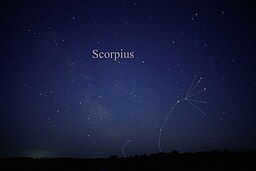
The Scorpius constellation can be observed with the naked eye, with its constellation lines drawn.
Scorpius contains several prominent stars, including Antares (α Sco), known as the “rival of Mars” due to its distinct reddish color; β Sco (Graffias or Akrab), a triple star; δ Sco (Dschubba, meaning “forehead”); θ Sco (Sargas, origin unknown); ν Sco (Jabba); ξ Sco; π Sco (Fang); σ Sco (Alniyat); and τ Sco (Paikauhale).
At the end of the scorpion’s curved tail, you can find λ Sco (Shaula) and υ Sco (Lesath), which are referred to as “sting” due to their names. Due to their close proximity, λ Sco and υ Sco are sometimes called cat’s eyes.
The bright stars of the constellation form a pattern resembling a harbor hook. Most of them are large members of the nearby OB: Scorpius-Centaurus association.
The star δ Sco, which used to have a stable magnitude of 2.3, experienced a sudden increase in brightness in July 2000, reaching 1.9 in just a few weeks. This event caused it to become a variable star, fluctuating between 2.0 and 1.6. As a result, it is now the second brightest star in Scorpius when it reaches its maximum brightness.
U Scorpius holds the record for being the fastest known new star, with a period of approximately 10 years.
The pair of stars ω¹ Scorpii and ω² Scorpii are visually distinct and can be observed without the aid of a telescope. They have strikingly different colors, with one appearing blue and the other yellow.
The star that was originally called γ Sco (although it is located in Libra) is now referred to as σ Lib. Additionally, in ancient Greek times, the entire constellation of Libra was considered to be the claws of Scorpio (Chelae Scorpionis), with Astrea holding the scales. These scales were later represented by the nearby Virgo in Greek times. The classification of these western stars into Libra was established during the Roman divisions.
Exploring celestial bodies in the vastness of the universe
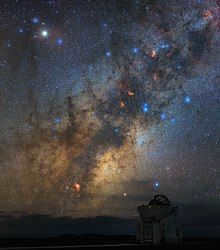
Scorpius and the Milky Way, including M4 and M80 near Antares, M6 and M7 directly below, NGC 6124 at the top, and NGC 6334 just above the center.
Messier 80 (NGC 6093) is a globular cluster with a magnitude of 7.3, located 33,000 light-years away from Earth. It is categorized as a compact Shepley Class II cluster, indicating a high concentration and density at its core. Charles Messier discovered M80 in 1781. In 1860, it became the site of a rare discovery when Arthur von Auwers found the new T Scorpii.
NGC 6302, also known as the Bug Nebula, is a bipolar planetary nebula. NGC 6334, also called the Cat’s Paw Nebula, is an emission nebula and a region where stars are forming.
Legend and Folklore
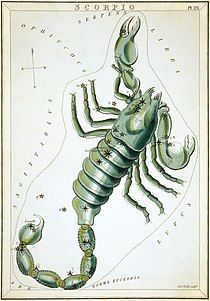
The constellation Scorpius is illustrated in the Mirror of Urania, a collection of star maps that were printed in London approximately in 1825.
According to Greek mythology, Scorpio is linked to Orion in several myths. In one account, Orion boasted to the goddess Artemis and her mother Leto that he would exterminate every animal on Earth. In response, Artemis and Leto dispatched a scorpion to eliminate Orion. The intense battle between the two caught the attention of Zeus, who decided to immortalize them in the heavens as a reminder to humans to control their excessive pride. Another version of the myth states that it was Artemis’ twin brother, Apollo, who sent the scorpion to kill Orion after he admitted that the goddess was superior to him, earning her favor. Once Zeus elevated Orion and the scorpion to the sky, the former hunts every winter but manages to evade the scorpion every summer. In both versions, Artemis appealed to Zeus to resurrect Orion.
In the Greek myth, the scorpion of the sky encountered Phaethon while he was driving his father Helios’ Solar Chariot.
Origin
The constellation was called MUL.GIR.TAB – “Scorpion” by the Babylonians, and the signs can be interpreted as “(a creature with) a burning sting”.
In some older descriptions, the constellation of Libra is considered to be the claws of Scorpio. In Babylonian, Libra was known as the Claws of Scorpio (zibānītu, compare Arabic zubānā), and in Greek it was called χηλαι (chelai).
Astrology
The Western zodiac sign Scorpio is different from the astronomical constellation. From November 23 through November 28, the Sun is astronomically in Scorpio for only six days. The majority of the variations are caused by the constellation of Serpentine, which is utilized by only a few astrologers. Scorpio corresponds to the Hindu nakshatras Anuradha, Jyeshtha, and Mula.
Culture
- The constellation Banyakangrem, which means “brooding swan” or Kalapa Doyong, which means “tilted coconut palm” is what Javanese people in Indonesia call Scorpius due to its similar shape.
- In Hawaii, Scorpius is referred to as the demigod Maui Fishing Hook or Ka Makau Nui o Māui, which translates to Big Maui Fishing Hook, and the specific name of the fishing hook was Manaiakalani.
- For navigation purposes, Bugis sailors divided Scorpius into two asterisms. The northern part of Scorpius (α, β, γ or σ Lib, δ, ε, ζ, μ, σ and τ Scorpius) was known as bintoéng lambarué, meaning “skate stars”. The southern part of Scorpius (η, θ, ι, κ, λ and ν Scorpii) was called bintoéng balé mangngiwéng, meaning “shark stars”.
References
- Levy, David H. (2005). Deep Sky objects. Prometheus Books. ISBN 1-59102-361-0. CS1 maint: ref = harv (link)
- Ridpath, Ian and Tirion, Wil (2007). Guide to Stars and Planets, Collins, London. ISBN 978-0-00-725120-9. Princeton University Press, Princeton. ISBN 978-0-691-13556-4.

